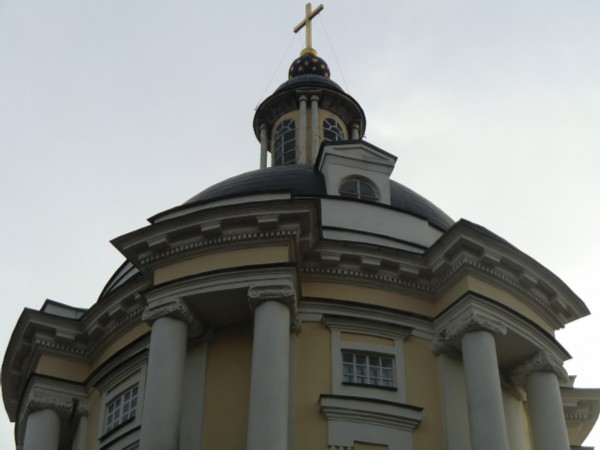
Moscow. The Vinogradovo estate. Temple of the Vladimir Icon of the Mother of God
Not far from the town of Dolgoprudny there is the Vinogradovo estate, “on the Dolgiy Pond”, known since the beginning of the 17th century. Now Vinogradovo is located within the city limits of Moscow, but in many reference books the estate is referred to the Moscow region.
In 1623 Gavrila Grigorievich Pushkin (the poet’s ancestor) acquired the village of Vinogradovo. During the reign of his sons, Gregory and Stepan, a wooden church was built in honor of the Vladimir Icon of the Mother of God with the chapel of St. Nicholas the Wonderworker. So Vinogradovo became a village.

History
The church was located not far from the Pushkin estate at the very dam of the Long Pond, which served as the entrance to the estate. There was no land at the church, the clergy was maintained at the expense of Grigory Gavrilovich. The stone temple was erected in 1696. In the 18th century, the village of Vinogradovo often changed owners (V.V. Dolgorukov, M.F. Vyazemskaya). Princess Maria Feodorovna Vyazemskaya built a side-chapel at the church in the name of the martyr John the Warrior. In 1758 the village was sold to Alexander Ivanovich Glebov, who was described by his contemporaries as “a state, outstanding figure of a reckless man and a predator.”

Catherine II wrote in her notes: “Glebov has very great abilities … but he is a rogue and a swindler.” By that time, a wall had collapsed in the church in the side-chapel of the Martyr John the Warrior and the Nikolsky side-chapel needed repair. It is not known whether the Gleb was repaired or not. No data has been preserved. The church fell into disrepair by the end of the 18th century, its parts were dismantled and in 1880 a cellar was built in it.
In 1772, Glebov decided to build a new church in another place, on the land of the Tyurikova wasteland (on the right side of the Dmitrov road, counting from Moscow). The construction of the temple took 5 years. The author of the project has not yet been established, but many historians believe that it was the architect V.I. Bazhenov, according to other versions of M.F. Kazakov. There is even an assumption that it was a French architect.



The architecture of the church is unique.
The temple is in the shape of a triangle in plan. Initially, there was only one altar in honor of the Vladimir Mother of God. The chapel of St. Nicholas the Wonderworker appeared 50 years later. The bell tower was erected separately from the altar at a distance of 80 steps, and a building with a clock painted on it was erected at the same distance to the southeast. All buildings are designed in the same style.

In September 1777, the temple was consecrated by Archbishop Platon (Levshin).
The many elements of this temple indicate the veneration of the Holy Trinity – 3 buildings in the ensemble (temple, bell tower and chapel), 3 corners (with curves) at the base of the church, 3 classic portals, 3 entrances to the temple.
The upper part of the temple consists of a round rotunda with columns, topped with a massive dome with a dome on a small light drum also having a dome. There is information that painters from the village of Fedorkino, the icon painter Gavril Antonov, the serf F. Tyutcheva, the goldsmith A. Kazantsev, worked on the decoration of the temple.


The temple has experienced many events.
During the Patriotic War of 1812, the village of Vinogradovo was occupied by the French and perpetrated a complete pogrom. There were horses in the altar in the church, a fire was made. The sacristy was plundered, church utensils were broken. The temple was never closed. And the services in it did not stop.
1941 to 1946 in the main altar of the church, under the throne, a great shrine was secretly kept – the head of St. Sergius of Radonezh. After the return of the head of the monk to the newly opened Trinity-Sergius Lavra, a particle of his relics was received for the temple. The left side-altar in honor of Sergius of Radonezh was built and consecrated in the temple.
Unfortunately, it is impossible to enter the territory of the Vinogradovo estate.


Interesting Facts.
When the estate belonged to the Benckendorffs (1790) G.R.Derzhavin, N.M. Karamzin and I.A. Krylov. Krylov wrote fables here – “The Oak and the Cane”, “The Choosy Bride”. At the beginning of the 20th century, the owners of Vinogradovo E.M. Banza and R.V. Herman restored and renovated the estate in the neoclassical and eclectic style.
Buildings were built for horse and cattle yards, a cinema club for hired workers. For peasant and yard children, Christmas trees were arranged in the main house of the estate. During the war of 1914, Herman set up a hospital for the wounded on his estate.
Now the estate is neglected, guards with dogs walk around the territory, but no one is engaged in the restoration of the estate.










